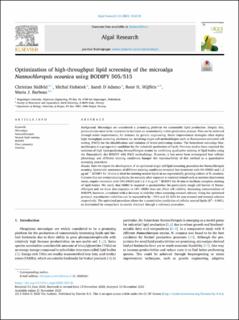Optimization of high-throughput lipid screening of the microalga Nannochloropsis oceanica using BODIPY 505/515
Südfeld, Christian; Hubáček, Michal; D'Adamo, Sarah; Wijffels, Rene Hubertus; Barbosa, Maria Hjelset
Journal article, Peer reviewed
Published version

Åpne
Permanent lenke
https://hdl.handle.net/11250/2730670Utgivelsesdato
2021-03Metadata
Vis full innførselSamlinger
- Department of Biological Sciences [2235]
- Registrations from Cristin [9791]
Sammendrag
Background
Microalgae are considered a promising platform for sustainable lipid production. Despite this, productivities need to be improved to facilitate an economically viable production process. This can be achieved through strain improvement, for instance by genetic engineering. Strain improvement strategies often deploy high-throughput screening platforms i.a. involving single-cell methodologies such as fluorescence-activated cell sorting (FACS) for the identification and isolation of better-performing strains. The heterokont microalga Nannochloropsis is a prospective candidate for the industrial production of lipids. Previous studies have reported the isolation of high lipid-producing Nannochloropsis strains by combining qualitative staining of lipid bodies using the fluorophoric dye BODIPY with FACS methodology. However, it has never been investigated how cellular physiology and different staining conditions hamper the reproducibility of this method as a quantitative screening procedure.
Results
Here we report the development of an optimized single cell lipid screening procedure for Nannochloropsis oceanica. Systematic assessment of different staining conditions revealed that treatment with 6% DMSO and 1.2 μg ml−1 BODIPY for 15 min is ideal for staining neutral lipids in an exponentially growing culture of N. oceanica. Cultures that are overproducing lipids, for example after exposure to external stimuli such as nutrient deprivation stress, require treatment with 10% DMSO and 1.2–1.6 μg ml−1 BODIPY for 36 min to facilitate complete staining of lipid bodies. We verify that DMSO is required to permeabilize the particularly tough cell barrier of Nannochloropsis and we show that exposure to 10% DMSO does not affect cell viability. Increasing concentrations of BODIPY, however, correlated with a decrease in viability when screening stressed cultures. Using the optimized protocol, reproductive viabilities can be expected to be ~91% and 83–82% for non-stressed and stressed cultures respectively. The optimized procedure allows for a quantitative prediction of cellular neutral lipids (R2= 0.981), as determined by comparison to results obtained through a reference procedure.
